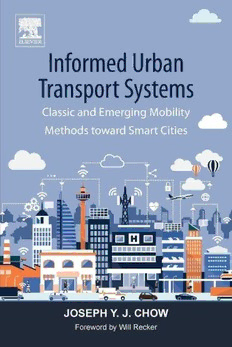
Informed Urban Transport Systems: Classic and Emerging Mobility Methods toward Smart Cities PDF
Preview Informed Urban Transport Systems: Classic and Emerging Mobility Methods toward Smart Cities
INFORMED URBAN TRANSPORT SYSTEMS INFORMED URBAN TRANSPORT SYSTEMS Classic and Emerging Mobility Methods toward Smart Cities JOSEPH Y.J. CHOW Elsevier Radarweg29,POBox211,1000AEAmsterdam,Netherlands TheBoulevard,LangfordLane,Kidlington,OxfordOX51GB,UnitedKingdom 50HampshireStreet,5thFloor,Cambridge,MA02139,UnitedStates ©2018ElsevierInc.Allrightsreserved. Nopartofthispublicationmaybereproducedortransmittedinanyformorbyanymeans, electronicormechanical,includingphotocopying,recording,oranyinformationstorageandretrieval system,withoutpermissioninwritingfromthepublisher.Detailsonhowtoseekpermission,further informationaboutthePublisher’spermissionspoliciesandourarrangementswithorganizations suchastheCopyrightClearanceCenterandtheCopyrightLicensingAgency,canbefoundatour website:www.elsevier.com/permissions. ThisbookandtheindividualcontributionscontainedinitareprotectedundercopyrightbythePublisher (otherthanasmaybenotedherein). Notices Knowledgeandbestpracticeinthisfieldareconstantlychanging.Asnewresearchandexperience broadenourunderstanding,changesinresearchmethods,professionalpractices,ormedicaltreatment maybecomenecessary. Practitionersandresearchersmustalwaysrelyontheirownexperienceandknowledgeinevaluatingand usinganyinformation,methods,compounds,orexperimentsdescribedherein.Inusingsuchinformation ormethodstheyshouldbemindfuloftheirownsafetyandthesafetyofothers,includingpartiesfor whomtheyhaveaprofessionalresponsibility. Tothefullestextentofthelaw,neitherthePublishernortheauthors,contributors,oreditors,assume anyliabilityforanyinjuryand/ordamagetopersonsorpropertyasamatterofproductsliability, negligenceorotherwise,orfromanyuseoroperationofanymethods,products,instructions,or ideascontainedinthematerialherein. LibraryofCongressCataloging-in-PublicationData AcatalogrecordforthisbookisavailablefromtheLibraryofCongress BritishLibraryCataloguing-in-PublicationData AcataloguerecordforthisbookisavailablefromtheBritishLibrary ISBN:978-0-12-813613-3 ForinformationonallElsevierpublicationsvisitour websiteathttps://www.elsevier.com/books-and-journals Publisher:JoeHayton AcquisitionEditor:TomStover EditorialProjectManager:ThomasVanderPloeg ProductionProjectManager:AnushaSambamoorthy CoverDesigner:VictoriaPearson TypesetbySPiGlobal,India LIST OF FIGURES Fig.1.1 OverviewofCanadianITSArchitectureversion2.0 6 Fig.1.2 DemonstrationofuseofMATSimtovisualizepublictransport boardingsandalightingsinSingapore 7 Fig.1.3 Comparisonofpersonalcomputer,smartphone,andtabletsales 8 Fig.1.4 AvisionofMobility-as-a-Service 9 Fig.1.5 DistributionofBIXIbikeshareinTorontoin2012 14 Fig.1.6 Manheim-Florian-Gaudryframeworkfortransportsystems analysis,withnewelementsingray 19 Fig.1.7 MATSimfunctionality 26 Fig.2.1 DemonstrationsofdataopportunitiesduetoadvancesinBig Dataandsmartcities:(A)usingTwitterdatatotrackurban mobilityduringHurricaneSandy;(B)real-timeCaliforniafreeway trafficmonitoringfromCaltransPeMS;(C)repositoryofreal-time andscheduledGTFSfeedsfromaroundtheworldincluding Paris;(D)calldetailrecordsusedtomodeltravelpatterns;(E)Taxi GPSdata 32 Fig.2.2 Atypologyofsmartcityfunctions 33 Fig.2.3 Columbussmartcitychallengeimplementationvision 35 Fig.2.4 IllustrationofconnectingIoTinfrastructurewithcities,users, operators,andsoftwaredevelopers 36 Fig.2.5 Illustrationofbeatsthatformpulsesuniquetodifferent locationsinacitydependingonthetypeofactivitydataused 39 Fig.2.6 Usinga(A)4-regionrepresentationofNYCand(B)illustrationof astandardizedpacevectorprogressingovertimebefore,during, andafterHurricaneSandy 41 Fig.2.7 (A)Originalillustrationofactivityprismsand(B)demonstration ofspace-timeaquariumofspace-timepathsofAfricanandAsian AmericansinPortland 44 Fig.2.8 (A)Minimumpathsand(B)velocityfieldisochronesforapoint 2.5mileseastofManchestercitycenterin1965 45 Fig.2.9 Constructingaleast-costpathfromacostvectorfield.(A) Initialization,(B)leastcostpathwithaccumulatedcosttoj,(C) temporallyreferencedleastcostpath,and(D)extractedpathas aspace-timepolyline 47 Fig.2.10 Illustrationofafield-basedspace-timeprismfromMillerand Bridwell(2009) 48 Fig.2.11 Illustrationoftwodifferentindividualvelocityvectors 48 Fig.2.12 (A)HouseholdtravelsurveydatafromGreaterTorontoArea;(B) kerneldensitymapofthetrajectoriesat8a.m.;(C)travel momentumfieldat8a.m.;(D)isometricviewsoftravel momentumfieldin(C) 51 Fig.2.13 ExampleforExercise2.2 53 vii viii ListofFigures Fig.2.14 (left)Beijing,China,and(right)totaldailyreal-timeGPSlocations from12,000taxisonNovember2,2012 54 Fig.2.15 SnapshotsofkerneldensityestimatedtaxipopulationTMF in24h 55 Fig.2.16 Illustrationofvectorprojection 56 Fig.2.17 TMFsforExercise2.3 57 Fig.2.18 Projectedvaluesandtemporalprofile 58 Fig.2.19 Busrouteno.506fromTorontoTransitCommission 59 Fig.2.20 TemporalprofileofrouteprojectionsofTMFonTTCbusno.506 59 Fig.2.21 (A)TMFsforExercise2.4and(B)projectvaluesalongwith temporalprofile 60 Fig.2.22 Magnitudeoftravelimpulsefieldbetween2011and2006TMFs at8a.m 61 Fig.3.1 Supply-demandcurvesforatransportsystem 70 Fig.3.2 Equilibriumallocationoftravelersontwoparallelroutes 72 Fig.3.3 NetworkforExercise3.3 74 Fig.3.4 BeforeandafterscenariosofnetworkforBraess’Paradox example 85 Fig.3.5 Illustrationoffreightassignmentof(A)path-basedcommodity flows,andsimultaneously,(B)link-basedcyclictruckandrail vehicularflows 94 Fig.3.6 SiouxFallsnetworkwithlinkIDsandlinkflows(ID/flow)underUE 96 Fig.3.7 IllustrationofnetworkassignmentinGreaterTorontoAreausing TransCAD 98 Fig.3.8 Illustrationoftransitlinesoperatingovera4-nodenetwork 99 Fig.3.9 Samplenetworktoillustratecommonlinesproblem 100 Fig.3.10 SamplenetworkforExercise3.9 102 Fig.3.11 Samplenetworkwithupdatedlinkcostfunctions forExercise3.10 106 Fig.3.12 Illustrationoftime-expandednetworkrepresentationofatransit networkwiththreelines 108 Fig.3.13 Equilibriumlinkflowsforeachofthreepassengergroups 109 Fig.3.14 MILATRASmodelframework 110 Fig.3.15 Queuerepresentedbycumulativedeparturesfromhome andarrivalsatwork 113 Fig.3.16 Bottleneckqueuewithoptimaltollappliedacrossoptimal timeinterval 115 Fig.3.17 PlotofqueuesformedfromexampleinExercise3.11 116 Fig.3.18 (A)Assumeddowntowncityblocksettingand(B)dynamicflows undersaturatedcondition 118 Fig.3.19 StudyareaindowntownToronto 121 Fig.3.20 Dynamicsofsearchfriction 124 Fig.3.21 Algorithmsto(A)runand(B)calibratethetaxiequilibriummodel 125 Fig.3.22 Relativespatialchangesinconsumersurplusfromsingle-ride taximarkettosharedtaxivia(A)matchingbywaiting and(B)matchingbydetour 127 ListofFigures ix Fig.3.23 Smartcitiesmobilityprovisionrepresentedasatwo-sided market 129 Fig.3.24 Illustrationofthesensitivityoftwo-sidedmarkettoplatform pricing 130 Fig.3.25 Componentsofagent-basedstochasticuserequilibrium obtainedbyday-to-dayadjustmentofuserandoperator decisionsasatwo-sidedmarket 134 Fig.4.1 A(A)4-nodenetworkonwhich(B)auserconductsactivities 140 Fig.4.2 Additionaltripgeneratedwithoutanyadditionaleconomic activity(Kangetal.,2013) 141 Fig.4.3 Disutilityofscheduledelaydependingontheflexibilityoflate arrival 143 Fig.4.4 Activitysystemtoillustrateflexibilityofmodeltocapture differentschedulingpreferences 153 Fig.4.5 ThreesolutionsofmHAPPbasedondifferentparameters foruser1(A,B)anduser2(C) 155 Fig.4.6 SolutionsofexampleinChow(2014)forasinglehousehold usingAlgorithm4.2,for(A)abaselinescenarioand(B)ascenario wherediscretionaryactivityutilityisdoubled 161 Fig.4.7 Overviewofdecompositionapproachtoobtainingmarket scheduleequilibrium 163 Fig.4.8 Cumulativediagramofarrivalsanddeparturesontolink(u,w) forExercise4.4 165 Fig.4.9 ActivityandtransportsystemforExercise4.5(driving:{(0,7), (0,6),(6,7)},transit:(8,9),walking:{(0,2),(0,8),(2,8),(2,7),(1,6), (1,9)}) 168 Fig.4.10 Algorithm4.3convergenceforExercise4.5 169 Fig.4.11 Cumulativediagram(A)withoutlinkcapacityand(B)withlink capacity 170 Fig.4.12 MATSiminputdata:(A)transitlineschedulefromGTFSoverlaid onaroadnetworkfromOpenStreetMapsand(B)activityzones correspondingtoNYMTChouseholdtravelsurvey 172 Fig.4.13 Schedulefilethatneedstobemodifiedforscenarioanalysis 173 Fig.4.14 Comparisonofdistributionofwelfaremeasureforusersofthe systembeforeandafterheadwayreduction 174 Fig.4.15 Comparisonofdistributionof7a.m.–10p.m.ridershiponthe AlinewithRegular(before)andReduced(after)headway 174 Fig.4.16 ComparisonofdistributionoftimeofdayarrivalsontotheAline attheW.4thStation(Station13)beforeandafterheadway reduction 175 Fig.4.17 Freightactivitysystem 179 Fig.5.1 IllustrationofastatechangeintheNguyen-Dupuisnetworkthat leadstoachangeinobservedflows 186 Fig.5.2 BayesiannetworkmodelofLuxembourgcommutermode choice 191 Fig.5.3 SamplenetworkforExercise5.1 196 x ListofFigures Fig.5.4 Exampledial-a-rideproblemforExercise5.2 200 Fig.5.5 OCTAMNetworkandactivitylocationsofhouseholdsinOrange County,CA,fromthe2001CaliforniaHouseholdTravelSurvey 203 Fig.5.6 ComparisonofHAPPoutputsbasedondifferentparameters 206 Fig.5.7 SampleGPSdatafromdrayagetrucksoutoftheSanPedroBay Ports 207 Fig.5.8 ComparisonofinverseVRPresultsforindividualandfleetoftwo vehicles 208 Fig.5.9 SamplenetworkforExercise5.3 209 Fig.5.10 ThirteenmajorairportsinCalifornia 211 Fig.5.11 Multiagentinverseoptimizationasafixed-pointproblem 214 Fig.5.12 IllustrationofAlgorithm5.2 215 Fig.5.13 TestnetworkwithnodeandlinkIDs 219 Fig.5.14 ConvergenceofAlgorithm5.2ontestnetwork 220 Fig.5.15 Outputdistributionofposteriorlinkcostsacrossthepopulation of500simulatedagentsforlink1(top)tolink5(bottom) 221 Fig.5.16 Toynetworkusedforillustratingmethodology 227 Fig.5.17 Nguyen-Dupuisnetwork 228 Fig.5.18 ConvergenceofdualpricesusingAlgorithm5.2A 230 Fig.5.19 Trajectoryofsimulatedrouteobservationsinanonlinelearning setting 231 Fig.5.20 Dualpricetrajectoriesbasedon300simulatedagentarrivals 231 Fig.5.21 Queensfreewaynetwork 232 Fig.5.22 Linkdualpricetrajectoriesobtainedfromonlinenetwork learning 233 Fig.5.23 Half-hourintervalscreenshotsofGoogleMapsreal-timeshortest pathqueries(Xuetal.,2017) 234 Fig.5.24 SnapshotsofmultiagentIOoutputdualpricesateveryhalfhour withnonzeropricesrepresentedbyheavierarrows 235 Fig.6.1 Laplacedistributednoiseaddedtofunctionsofvaluesfrom SandS0 242 Fig.6.2 IllustrationoffilteredincomedataaccordingtoE¼{1000,100} 246 Fig.6.3 Spatialdistributionandtraveltimesbetweenzonecentroids, and20sampleODlocations 249 Fig.6.4 DistributionsoflocationnoisebyoriginzoneforE¼5 249 Fig.6.5 ComparisonofODdistributionsfororiginalandE-differentially privatelocations 251 Fig.6.6 Frameworkfork-anonymousdiffusionmodels 253 Fig.6.7 (A)Originalflows,(B)outcomeassignmenttominimize repeatingtheoriginalflows,and(C)theoutcomeassignment tominimizerepeatingthecombinedflowsontheleft 254 Fig.6.8 Shiftofprobabilitiesfrommaximumprobabilityfororiginflows tounconstrainedmaximumentropy 258 Fig.6.9 (A)Exampletour,with(B)truevehiclearrivaltimesand passengertraveltimes,and(C)otherknownparameters 262 Fig.6.10 Diffusionof(0,2,1,3,5,4,6,0)into90tourswithΔ¼0.1 263 Fig.6.11 Ten-anonymousdiffusionof(0,2,1,3,5,4,6,0)usingAlgorithm 6.2withΔ¼0.10 264 ListofFigures xi Fig.6.12 Comparisonofentropyvaluefornumberoftoursunderdifferent tourgenerationmethods 264 Fig.6.13 Two-pathdiffuseddataobjectset 267 Fig.6.14 Two-anonymousdistributionofposteriorlink7dualpriceasa functionofprior 267 Fig.7.1 Typesofproblemsbycomplexity 276 Fig.7.2 NetworkusedforExercise7.1 279 Fig.7.3 IterationsofPrim’sAlgorithmforExercise7.1 280 Fig.7.4 IllustrationoftheSteinerTreeProblem 281 Fig.7.5 SevenbridgesofKo€nigsberg 282 Fig.7.6 Illustrationofworst-casematchedodd-degreenodelengths 284 Fig.7.7 OptimalsolutiontoTSPusingintegerprogramming 284 Fig.7.8 EuleriantourobtainedusingAlgorithm7.2 285 Fig.7.9 Severaliterationsofannearestneighborheuristiconexample fromFig.7.2 286 Fig.7.10 InstanceforExercise7.3 290 Fig.7.11 Optimalsolutionobtainedbyintegerprogramming 291 Fig.7.12 OptimalsolutiontoDARPexample 293 Fig.7.13 InstanceforExercise7.5 297 Fig.7.14 OptimalsolutionviaintegerprogrammingfortwoPvalues 298 Fig.7.15 Optimalsolutionstosetcoveringproblemwiths¼1,s¼2 301 Fig.7.16 Facilitylocationbasedon(A)nodes,(B)flow,and(C)itinerary intercept 305 Fig.7.17 Solutionsto(A)relocationignoringqueuedelayand(B) relocationwithqueuedelay 308 Fig.7.18 Illustrationoflineplanningproblem 309 Fig.7.19 InputdataforExercise7.11 314 Fig.7.20 IllustrationofabilevelprobleminEq.(7.20)withnosolution 318 Fig.7.21 Fourstepstosurrogate-basedNDP:(A)generatesample solutions,(B)fitasurrogatemodeltothesamples,(C)ensure feasibilityofsamplesolutions,(D)selectnewsolutionusing surrogatemodel 319 Fig.7.22 NetworkusedforExercise7.12 320 Fig.7.23 TwolayersofAlgorithm7.6onExercise7.13 321 Fig.7.24 ExampleforExercise7.15 328 Fig.7.25 Lower(0,0,0)andupperbound(1,1,1)solutionsattherootnode 329 Fig.7.26 (A)Regionsforclassifyingsymbioticnetworkdesignstrategies and(B)impactofnetworkexpansionandcontraction 333 Fig.7.27 ExamplenetworkforExercise7.16 334 Fig.7.28 Objectivespaceofthealternativesolutions 334 Fig.7.29 Examplewith(A)substitutabletollroadsand(B)complementary tollroads 336 Fig.8.1 Examplesofstochasticvariables:(A)aprobabilitydensity functionofarandomvariablewithatriangulardistribution and(B)correspondingcumulativedistributionfunction oftriangulardistribution 343 xii ListofFigures Fig.8.2 Examplesofstochasticprocesses:(A)firstand(B)second instancesofasimulation(t¼[0,5])andprojection(t¼(5,6]) ofageometricBrownianmotionwithμ¼0.1,σ¼0.4 350 Fig.8.3 ExpandingtheNPVdecisionspace(topregion)tofourother regionsasopportunities 353 Fig.8.4 Distributionsofprofitundercommitment(solid)andoption (dashed)investments 354 Fig.8.5 PlotofprojectvalueRandthecorrespondingoptionvalueV fortwoprojects 357 Fig.8.6 (A)SiouxFallsnetworkwithcandidatelinksand(B)comparison ofdeferralwithredesign(NetworkInvestmentDeferralOption (NIDO))todeferralonlyasfunctionofσ 364 Fig.8.7 Illustrationofmarketswitching 365 Fig.8.8 Comparisonoftwotrajectories(Q1,Q2)fromaninitialpoint Q0¼$0.75 368 Fig.8.9 (A)SingleOD,three-linkexamplewith(B)aplotofthebaselink costfunctionsand(C)simulatedtrajectoriesofQovera2-year horizon 375 Fig.8.10 ComparisonoftheCR-WeibulldistributionsforCityA(F )and A CityB(F ) 382 B Fig.8.11 SimulationofHyyti€aetal.(2012)dynamicdispatchpolicy 383 Fig.8.12 Evaluationofmyopicandnonmyopicpoliciesrelativeto CR-Weibulldistributions.(A)ScenarioA,(B)ScenarioB, and(C)ScenarioC 384 Fig.B.1 Systemsengineeringprocess 416 Fig.B.2 Usecasediagramsfor(A)on-busfareticketingand(B)roadside fareticketing 419 Fig.B.3 Aconceptualdiagramfortheroadsidebusticketingsystem 420 Fig.B.4 AnactivitydiagramwithswimlanesforPayFareusecasein roadsideticketing 421 Fig.B.5 AdeploymentdiagramofthePT04TransitFareCollection Managementusecase 422 Fig.C.1 Examplestatetransitiondiagram 427 Fig.C.2 Statetransitiondiagramofabirth-and-deathprocess,ofwhich theM/M/1modelisone 430 Fig.C.3 ComparisonofthestateprobabilitiesforM/M/1andM/M/1/1 queues 434 Fig.C.4 Regionforaspatialqueueanalysiswithasingleshuttlebasedat acentraldepot 435 Fig.C.5 Exampleofaqueuenetwork 437 Fig.D.1 Illustrationofisoutilitycurvesandresourceexpenditurebudget (straightline) 440 Fig.D.2 Derivationofindividualdemandfunctionfromutilitycurves 441 Fig.D.3 ComparisonofCDFsofε 444 n Fig.D.4 Nestedlogitexample 448 Fig.D.5 Illustrationofnonconvexityofrevenuemaximizationontwo segmentswithp ¼$2 454 2
